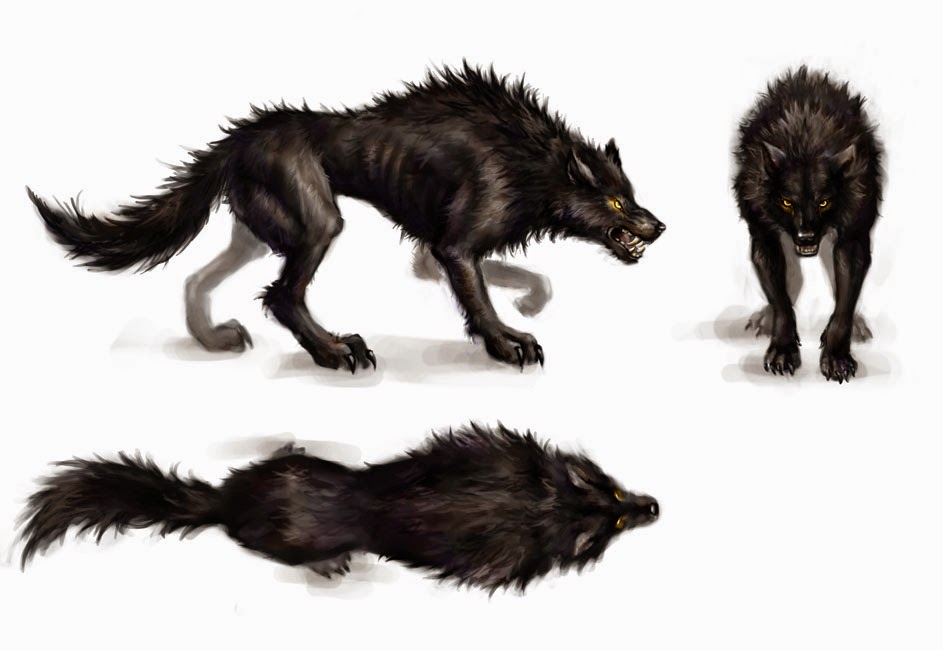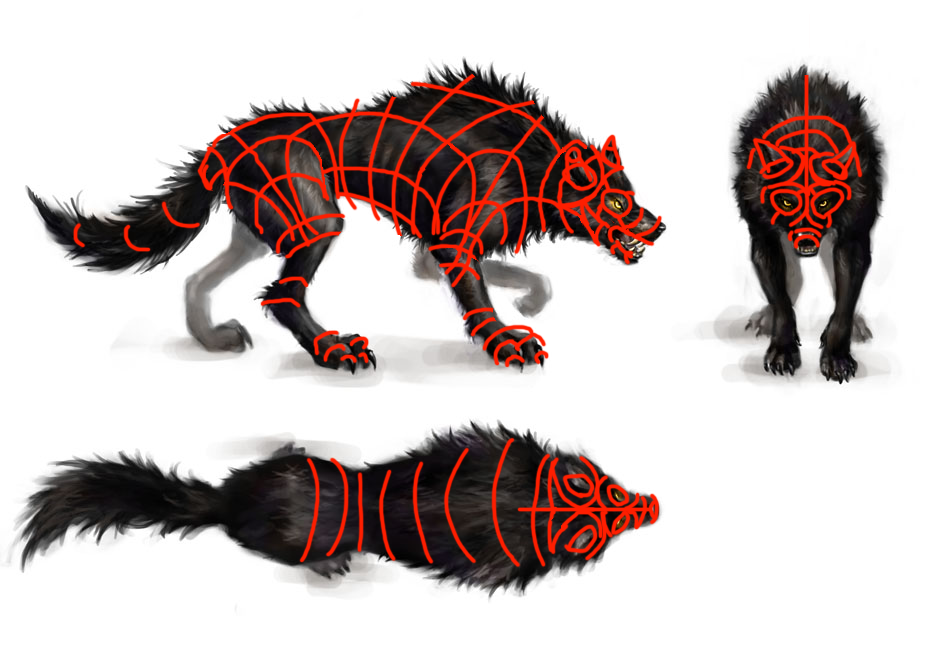A little while ago I started working on a character model for school. The assignment was to first choose concept art of a character and give it a backstory. After pre-production you are to make a low poly with a good organic edgeflow, maximum 3k tris. It is then to be UV mapped and textured at a 1024x1024 resolution so you're really limited with both tris and resolution.
I haven't completed my model yet but I believe I'm well on my way. As for what concept I chose I felt that I didn't want to do anything I've done before so I ended up looking up animals instead. After looking for a while I found a really cool concept of a feral wolf. I really like how this looks and I'm looking forward to making the fur. Here below is some pictures and after that is the backstory I planned for the character.
 |
| Here's the concept I decided on. While the turn around isn't perfect (the wolf is in a walk cycle and things aren't lined up) I still have a lot to go on. |
 |
| A quick draw over to plan my edgeflow |
Name: Gnaw
Appearance: A gigantic male dire wolf with rugged ink-black fur, rivaling even a grizzly bear in size. A first impression would only describe Gnaw as ferocious, deadly and yet majestic.
A yellow glowing stare that pierces through the night and razorsharp fangs and claws surely you wouldn't want to have a meeting with this wolf.
Huge dire wolves like Gnaw tend to live long lives, longer than your average human under the right condititions. Though age unknown Gnaw has been around long enough to have tales told and songs sung about him. Even among dire wolves Gnaw is special, he has been around for atleast 90 years.
Gnaw's body is made for combat and hunting, a predator at heart. Under his thick rugged fur lies countless scars from various battles. As one of the most powerful creature on the top of the food chain, Gnaw dislikes being toyed with and controlled. He has an iron will and a strong mental fortitude.
Gnaw wanders around his den in the forest with his four predatory legs. It is not unusual for him to move out of his territory occasionally, usually to hunt new prey or defeat rivals. When hunting he moves swiftly and stealthily, although his huge body makes it harder. Prefers to hunt alone.
Gnaw prefers to eat prey that can fight back, large animals like moose or bears although they do not put up much of a fight. His absolute favourite food though is the blood and flesh of his enemies or rivals. Gnaw wants tough prey like sabre toothes or mammoths and after his victory he eats them in an almost ritual-like manner. His opinions on humans are that they are weak, fragile creature that only act as irritation for the grander matter of things. They attempt to use weapons and fire to drive Gnaw away but it is futile seeing how dwarfed they are by this ferocious dire wolf. Even in larger numbers they eventually flee for their lives, weapons left behind. Although the weapons do make for nice decorations by his lair.
Although he is talented with tactics and has a high intelligence he prefers to play with his prey. If there is no challenge, make one. He gives his enemies a significant advantage in fights and hunts so he can enjoy himself. He is more for physical challenges than intellectual ones and tries not to think too much.
Not much is known about Gnaw, he just simply appeared one day and changed the hierarchy of the forests. Many have tried to best him in combat, all have lost and few land a wound on him. There are times when enemies would come to ambush Gnaw in packs but his combat prowess and intimidation would end up scaring them away although many of his scars were from those ambushes. His biggest secret is what took place before his appearance. His childhood must have had quite the impression on him seeing as he is now.
His main goal in life is much related to his hobby which is fighting with his life on the line and winning. All he really wants is the title of the strongest although a lonewolf it his to himself he must prove his worth. He is continually expanding his territory to prove his worth and defeat new enemies.
And that's his background, I left a lot of things untold to preserve his mysterious image and let other people fill in the blanks so they can create their own theories. This character would fit very well into a game like Dark Souls as a boss. He is dangerous and intimidating, if he was a boss in a game I'm sure that the player will be backed up into a corner and fighting for his life. You would play as some kind of warrior or knight and Gnaw would be a major obstacle to overcome.
This would fit best on a console as they tend to immerse the player more than sitting on a PC with distractions, also for the comfortable controls. The target audience for this game would be players who enjoys challenges and like exploring the world and learning more about it. I tried to describe the game world I can see Gnaw fitting in below with some crappy rhymes because why not!
Glowing eyes lurking in a dark misty land.
In the forests deep a spider's web so grand.
Wyverns soaring in the sky roaming around mountains of heaven high,
forests thicker than the darkest blood and fierce rivers just waiting to flood.
This world has a very chaotic eco system as there are many dangerous creatures lurking about, Gnaw being one of them. So in this world Gnaw would be the baddest of the bad and you would probably end up fighting him sooner or later. Well that's it for me, my next post will be more on the actual production of Gnaw. I'll show you the process I'm using in his creation and my final results. Thanks for reading!





































